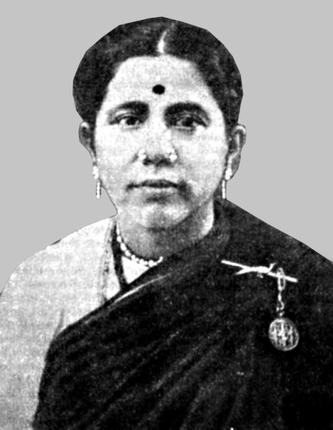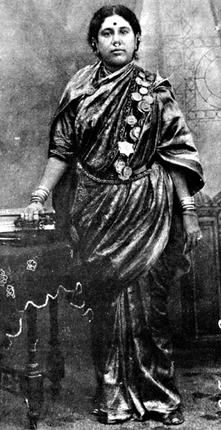
Saraswati Bai, the phenomenally talented first woman Harikatha artiste of south India, came from poor circumstances. With a fine guru, and great patrons, she rose to the top against all odds and was called Lady Bhagavathar

Years ago I happened to hear a short rpm recording of C. Saraswati Bai; it was the famous kriti “Aada Modi Galade”. Robust and full throated, her non fussy music left an impact on me. Years later, when I saw her on the cover page of the Sruti magazine, the Charukeshi kriti emerged dusting cobwebs of memory. Music historian Sriram V. had written an extensive story on the life and music of Saraswati Bai, and it continued in the next issue of the magazine. It was a thrilling experience to read the story of Saraswati Bai, and somehow it immediately took me to the life of Kannada’s early woman writer Saraswati Bai Rajwade’s. Was there a connection beyond the name – not beyond their grit and determination perhaps. Of course, that they were woman who occupied the same period in history and struggled to change its course was also common to them.
Apart from Sriram V.’s wonderful essay on Saraswati Bai and a commemorative volume put together by M.S. Ramaswami Aiyar, there is not much information available on her. As Sriram himself says, Saraswati Bai wrote a sketch of her life in 1935 for the Tamil magazine Ananda Vikatan which is the only other authentic source. Lady Bhagavathar, as this first harikatha woman exponent was called, and Brahmin at that, led a life that was marked by ups and downs. But it is worth recalling her story not only because it allows us to re-read history, but also for her passion for learning which remained a constant through all the adversities she encountered. It is important to revisit because many of these forces, in our minds are always oppositional in nature – man and woman, upper caste and lower caste, rich and poor. But, they have integrated in heart-warming ways to make this great story of Saraswati Bai.
Born to the Madhwa Brahmin couple Rangammal and Rama Rao in 1892, Saraswati Bai’s life was to change when her mother Rangammal nursed the cholera stricken, wealthy Venkataswami Naidu back to health. Circumstances took Rama Rao’s family from Renigunta to Madras and they lived in close relationship with the Naidu family. Saraswati Bai accompanied Venkataswami Naidu’s great grand daughter Narasamma to her Hindustani music classes with Yakoob Ali Khan and just by being a passive onlooker she had learnt “songs, how to play the sitar and harmonium.” Several musicians such as Veena Dhanammal, Abdul Karim Khan, Hirabai Badodekar… visited the Naidu household giving the eager Saraswati a footing in music. Sanskrit scholar Krishnachar who happened to listen to Saraswati sing at an informal gathering was determined to teach the girl. A teacher at the Madras Christian College, Krishnachar became a devout guru and taught her Sanskrit along with a few Carnatic kritis. He took her to top artistes of those times – T.S. Sabesa Iyer, Muthaih Bhagavathar, Pudukottai Dakshinamurthy Pillai and several others, making sure that she learnt the best from their repertoire. He was so obsessed with teaching the young Saraswati that he even neglected his job.
If the support Krishnachar gave Saraswati was phenomenal, the encouragement the Naidu family extended to her was equally important. They provided opportunities for her to perform harikatha discourses and soon, Saraswati’s knowledge and depth was being widely discussed. She was married as a child, and her husband took care of the house and allowed her to pursue her passion. But with her rise, they began to cast aspersions on her character. Her guru was sufficiently maligned and he was even asked to give up his post in the college. People stopped attending her performances, getting sabha became impossible, finding accompanists was a herculean task. Vidwans who had accompanied her were ostracized by the Brahmin community and were later forced to undergo ritual purification. Saraswati Bai wrote: “If I were to list out the ways in which I was insulted and troubled by men, it would disgust the reader.” But the backing of her guru was solid.
She relentlessly held on, and with growing public support, in the years to come, none could stop Saraswati Bai’s increasing popularity. In 1911, as a 19-year old, she travelled widely across India giving performances. Saraswati Bai also went to Sri Lanka and by the time she turned 22, she was one of the most accomplished Harikatha performers. Saraswati Bai was greatly appreciated by the stars of her time like Dhanammal and Mukta. In fact, she paved the path for other Brahmin women to pursue their interests.
Sriram V. records F.G. Natesa Iyer (in 1939) as saying: “Saraswati Bai is a pioneer, and today, as a result of her sacrifices…. Brahmins and non-Brahmins walk freely over the once forbidden ground. C. Saraswati Bai has achieved this miracle.”
This is the first of a four-part series on women from the world of Performing Arts
source: http://www.thehindu.com / The Hindu / Home> Features> MetroPlus / by Deepa Ganesh / February 12th, 2015